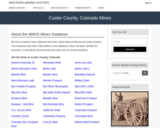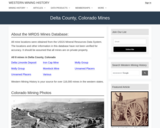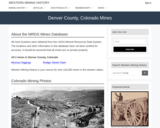Copper is an element that is essential to our technology and to our standard of living. Commonly, the copper is extracted from a variety of copper-bearing minerals that occur in veins. These fossilized fluid pathways record a complex set of geologic processes with non-linear couplings that are the products of hydrothermal activity associated with igneous intrusions (e.g. heat transport, mechanical fracture, mineral precipitation, permeability changes). By carefully examining a rock slab and its mineralogy, one can decipher the series of interrelated processes and their resultant impact on the final product.
Students set about to determine the relative age of veins by visual examination of the rock slab provided. Several generations of veins are recorded by different colors representing different minerals. Using cross-cutting relationships, they list the veins from oldest to youngest. Based on their color, they determine the sequence of minerals that fill veins. This provides an opportunity to review why color can be used to identify some minerals but not others. Once minerals are identified, their ideal chemical formula allows the percent copper in the mineral to be determined as well as the additional elements that must be present to form the mineral. The consequent change in mineral chemistry can be linked to the alterations in fluids flowing through the fractures by analysis of fluid-mineral equilibria on activity-activity (a-a) diagrams. For the more advanced classes, relevant thermodynamic data can be provided and students can write hydrolysis reactions and calculate the (a-a) diagram themselves.
Interpretation of the geologic history begins with the matrix and initial conditions and follows through rock fracture, fluid flow, mineral precipitation, evolving fluid composition, fracture sealing, pore-fluid pressure buildup, fracture, precipitation, etc. in a series of feedbacks. A feedback diagram can be provided and used as a base-map for interpretation not only of the sequence but changes to each reservoir, or students can be asked to draw the series of events and their reservoirs with the mechanisms of change. In the end, students understand the complex series of geologic processes that must come together in space and time to produce an ore-deposit that can be mined for our use. They also wrestle with the complications of reading the rock record and with the ambiguity of interpreting the interaction of various mechanisms that control the final product.
(Note: this resource was added to OER Commons as part of a batch upload of over 2,200 records. If you notice an issue with the quality of the metadata, please let us know by using the 'report' button and we will flag it for consideration.)



